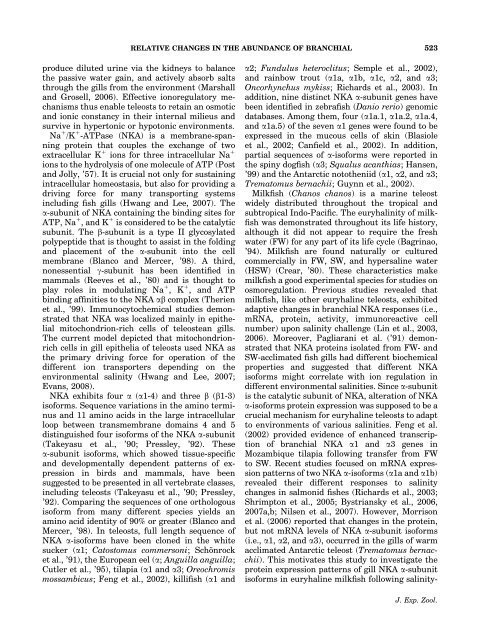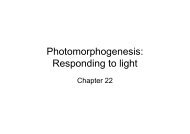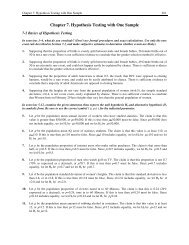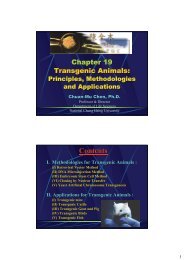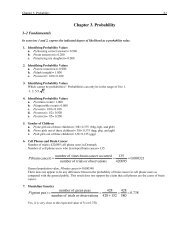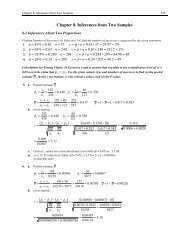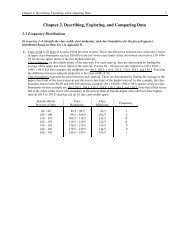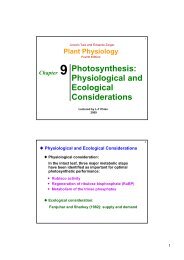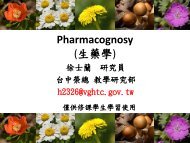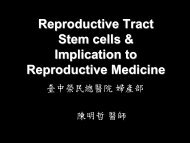isoform-like proteins in marine euryhaline milkfish (Chanos
isoform-like proteins in marine euryhaline milkfish (Chanos
isoform-like proteins in marine euryhaline milkfish (Chanos
You also want an ePaper? Increase the reach of your titles
YUMPU automatically turns print PDFs into web optimized ePapers that Google loves.
RELATIVE CHANGES IN THE ABUNDANCE OF BRANCHIAL 523produce diluted ur<strong>in</strong>e via the kidneys to balancethe passive water ga<strong>in</strong>, and actively absorb saltsthrough the gills from the environment (Marshalland Grosell, 2006). Effective ionoregulatory mechanismsthus enable teleosts to reta<strong>in</strong> an osmoticand ionic constancy <strong>in</strong> their <strong>in</strong>ternal milieus andsurvive <strong>in</strong> hypertonic or hypotonic environments.Na 1 /K 1 -ATPase (NKA) is a membrane-spann<strong>in</strong>gprote<strong>in</strong> that couples the exchange of twoextracellular K 1 ions for three <strong>in</strong>tracellular Na 1ions to the hydrolysis of one molecule of ATP (Postand Jolly, ’57). It is crucial not only for susta<strong>in</strong><strong>in</strong>g<strong>in</strong>tracellular homeostasis, but also for provid<strong>in</strong>g adriv<strong>in</strong>g force for many transport<strong>in</strong>g systems<strong>in</strong>clud<strong>in</strong>g fish gills (Hwang and Lee, 2007). Thea-subunit of NKA conta<strong>in</strong><strong>in</strong>g the b<strong>in</strong>d<strong>in</strong>g sites forATP, Na 1 , and K 1 is considered to be the catalyticsubunit. The b-subunit is a type II glycosylatedpolypeptide that is thought to assist <strong>in</strong> the fold<strong>in</strong>gand placement of the a-subunit <strong>in</strong>to the cellmembrane (Blanco and Mercer, ’98). A third,nonessential g-subunit has been identified <strong>in</strong>mammals (Reeves et al., ’80) and is thought toplay roles <strong>in</strong> modulat<strong>in</strong>g Na 1 , K 1 , and ATPb<strong>in</strong>d<strong>in</strong>g aff<strong>in</strong>ities to the NKA ab complex (Therienet al., ’99). Immunocytochemical studies demonstratedthat NKA was localized ma<strong>in</strong>ly <strong>in</strong> epithelialmitochondrion-rich cells of teleostean gills.The current model depicted that mitochondrionrichcells <strong>in</strong> gill epithelia of teleosts used NKA asthe primary driv<strong>in</strong>g force for operation of thedifferent ion transporters depend<strong>in</strong>g on theenvironmental sal<strong>in</strong>ity (Hwang and Lee, 2007;Evans, 2008).NKA exhibits four a (a1-4) and three b (b1-3)<strong>isoform</strong>s. Sequence variations <strong>in</strong> the am<strong>in</strong>o term<strong>in</strong>usand 11 am<strong>in</strong>o acids <strong>in</strong> the large <strong>in</strong>tracellularloop between transmembrane doma<strong>in</strong>s 4 and 5dist<strong>in</strong>guished four <strong>isoform</strong>s of the NKA a-subunit(Takeyasu et al., ’90; Pressley, ’92). Thesea-subunit <strong>isoform</strong>s, which showed tissue-specificand developmentally dependent patterns of expression<strong>in</strong> birds and mammals, have beensuggested to be presented <strong>in</strong> all vertebrate classes,<strong>in</strong>clud<strong>in</strong>g teleosts (Takeyasu et al., ’90; Pressley,’92). Compar<strong>in</strong>g the sequences of one orthologous<strong>isoform</strong> from many different species yields anam<strong>in</strong>o acid identity of 90% or greater (Blanco andMercer, ’98). In teleosts, full length sequence ofNKA a-<strong>isoform</strong>s have been cloned <strong>in</strong> the whitesucker (a1; Catostomus commersoni; Schönrocket al., ’91), the European eel (a; Anguilla anguilla;Cutler et al., ’95), tilapia (a1 and a3; Oreochromismossambicus; Feng et al., 2002), killifish (a1 anda2; Fundulus heteroclitus; Semple et al., 2002),and ra<strong>in</strong>bow trout (a1a, a1b, a1c, a2, and a3;Oncorhynchus mykiss; Richards et al., 2003). Inaddition, n<strong>in</strong>e dist<strong>in</strong>ct NKA a-subunit genes havebeen identified <strong>in</strong> zebrafish (Danio rerio) genomicdatabases. Among them, four (a1a.1, a1a.2, a1a.4,and a1a.5) of the seven a1 genes were found to beexpressed <strong>in</strong> the mucous cells of sk<strong>in</strong> (Blasioleet al., 2002; Canfield et al., 2002). In addition,partial sequences of a-<strong>isoform</strong>s were reported <strong>in</strong>the sp<strong>in</strong>y dogfish (a3; Squalus acanthias; Hansen,’99) and the Antarctic nototheniid (a1, a2, and a3;Trematomus bernachii; Guynn et al., 2002).Milkfish (<strong>Chanos</strong> chanos) is a mar<strong>in</strong>e teleostwidely distributed throughout the tropical andsubtropical Indo-Pacific. The euryhal<strong>in</strong>ity of <strong>milkfish</strong>was demonstrated throughout its life history,although it did not appear to require the freshwater (FW) for any part of its life cycle (Bagr<strong>in</strong>ao,’94). Milkfish are found naturally or culturedcommercially <strong>in</strong> FW, SW, and hypersal<strong>in</strong>e water(HSW) (Crear, ’80). These characteristics make<strong>milkfish</strong> a good experimental species for studies onosmoregulation. Previous studies revealed that<strong>milkfish</strong>, <strong>like</strong> other euryhal<strong>in</strong>e teleosts, exhibitedadaptive changes <strong>in</strong> branchial NKA responses (i.e.,mRNA, prote<strong>in</strong>, activity, immunoreactive cellnumber) upon sal<strong>in</strong>ity challenge (L<strong>in</strong> et al., 2003,2006). Moreover, Pagliarani et al. (’91) demonstratedthat NKA <strong>prote<strong>in</strong>s</strong> isolated from FW- andSW-acclimated fish gills had different biochemicalproperties and suggested that different NKA<strong>isoform</strong>s might correlate with ion regulation <strong>in</strong>different environmental sal<strong>in</strong>ities. S<strong>in</strong>ce a-subunitis the catalytic subunit of NKA, alteration of NKAa-<strong>isoform</strong>s prote<strong>in</strong> expression was supposed to be acrucial mechanism for euryhal<strong>in</strong>e teleosts to adaptto environments of various sal<strong>in</strong>ities. Feng et al.(2002) provided evidence of enhanced transcriptionof branchial NKA a1 and a3 genes <strong>in</strong>Mozambique tilapia follow<strong>in</strong>g transfer from FWto SW. Recent studies focused on mRNA expressionpatterns of two NKA a-<strong>isoform</strong>s (a1a and a1b)revealed their different responses to sal<strong>in</strong>itychanges <strong>in</strong> salmonid fishes (Richards et al., 2003;Shrimpton et al., 2005; Bystriansky et al., 2006,2007a,b; Nilsen et al., 2007). However, Morrisonet al. (2006) reported that changes <strong>in</strong> the prote<strong>in</strong>,but not mRNA levels of NKA a-subunit <strong>isoform</strong>s(i.e., a1, a2, and a3), occurred <strong>in</strong> the gills of warmacclimated Antarctic teleost (Trematomus bernacchii).This motivates this study to <strong>in</strong>vestigate theprote<strong>in</strong> expression patterns of gill NKA a-subunit<strong>isoform</strong>s <strong>in</strong> euryhal<strong>in</strong>e <strong>milkfish</strong> follow<strong>in</strong>g sal<strong>in</strong>ity-J. Exp. Zool.


